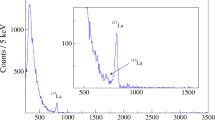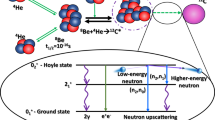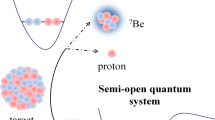Abstract
Particle knockout scattering experiments1,2 are fundamental for mapping the structure of atomic nuclei2,3,4,5,6, but their interpretation is often complicated by initial- and final-state interactions of the incoming and scattered particles1,2,7,8,9. Such interactions lead to reduction in the scattered particle flux and distort their kinematics. Here we overcome this limitation by measuring the quasi-free scattering of 48 GeV c–1 12C ions from hydrogen. The distribution of single protons is studied by detecting two protons at large angles in coincidence with an intact 11B nucleus. The 11B detection suppresses the otherwise large distortions of reconstructed single-proton distributions induced by initial- and final-state interactions. By further detecting residual 10B and 10Be nuclei, we also identified short-range correlated nucleon–nucleon pairs9,10,11,12,13 and provide direct experimental evidence for separation of the pair wavefunction from that of the residual many-body nuclear system9,14. All measured reactions are well described by theoretical calculations that include no distortions from the initial- and final-state interactions. Our results showcase the ability to study the short-distance structure of short-lived radioactive nuclei at the forthcoming Facility for Antiproton and Ion Research (FAIR)15 and Facility for Rare Isotope Beams (FRIB)16 facilities, which is relevant for understanding the structure and properties of nuclei far from stability and the formation of visible matter in the Universe.
This is a preview of subscription content, access via your institution
Access options
Access Nature and 54 other Nature Portfolio journals
Get Nature+, our best-value online-access subscription
$29.99 / 30 days
cancel any time
Subscribe to this journal
Receive 12 print issues and online access
$209.00 per year
only $17.42 per issue
Buy this article
- Purchase on Springer Link
- Instant access to full article PDF
Prices may be subject to local taxes which are calculated during checkout




Similar content being viewed by others
Data availability
Source data are provided with this paper. All other data that support the plots within this paper and other findings of this study are available from the corresponding author upon reasonable request.
References
Jacob, G. & Maris, T. A. J. Quasi-free scattering and nuclear structure. Rev. Mod. Phys. 38, 121–142 (1966).
Kelly, J. J. Nucleon knockout by intermediate energy electrons. Adv. Nucl. Phys. 23, 75–294 (1996).
Gade, A. et al. Reduction of spectroscopic strength: weakly-bound and strongly-bound single-particle states studied using one-nucleon knockout reactions. Phys. Rev. C 77, 044306 (2008).
Kobayashi, T. et al. (p, 2p) reactions on 9–16C at 250 MeV/A. Nucl. Phys. A 805, 431–438 (2008).
Wakasa, T., Ogata, K. & Noro, T. Proton-induced knockout reactions with polarized and unpolarized beams. Prog. Part. Nucl. Phys. 96, 32–87 (2017).
Duer, M. et al. Probing high-momentum protons and neutrons in neutron-rich nuclei. Nature 560, 617–621 (2018).
Hansen, P. G. & Tostevin, J. A. Direct reactions with exotic nuclei. Ann. Rev. Nucl. Part. Sci. 53, 219–261 (2003).
Cosyn, W. & Ryckebusch, J. On the density dependence of single-proton and two-proton knockout reactions under quasifree conditions. Phys. Rev. C 80, 011602 (2009).
Ciofi degli Atti, C. In-medium short-range dynamics of nucleons: recent theoretical and experimental advances. Phys. Rep. 590, 1–85 (2015).
Subedi, R. et al. Probing cold dense nuclear matter. Science 320, 1476–1478 (2008).
Feldmeier, H., Horiuchi, W., Neff, T. & Suzuki, Y. Universality of short-range nucleon-nucleon correlations. Phys. Rev. C 84, 054003 (2011).
Hen, O. et al. Momentum sharing in imbalanced Fermi systems. Science 346, 614–617 (2014).
Hen, O., Miller, G. A., Piasetzky, E. & Weinstein, L. B. Nucleon-nucleon correlations, short-lived excitations, and the quarks within. Rev. Mod. Phys. 89, 045002 (2017).
Cruz-Torres, R. et al. Many-body factorization and position–momentum equivalence of nuclear short-range correlations. Nat. Phys. https://doi.org/10.1038/s41567-020-01053-7 (2020).
Spiller, P. & Franchetti, G. The FAIR accelerator project at GSI. Nucl. Instrum. Meth. A 561, 305–309 (2006).
FRIB400: The Scientific Case for the 400 MeV/u Energy Upgrade of FRIB (FRIB Science Community, 2019); https://frib.msu.edu/_files/pdfs/frib400_final.pdf
Mukherjee, B. et al. Spectral response and contact of the unitary Fermi gas. Phys. Rev. Lett. 122, 203402 (2019).
Bloch, I., Dalibard, J. & Zwerger, W. Many-body physics with ultracold gases. Rev. Mod. Phys. 80, 885–964 (2008).
Schmidt, A. et al. Probing the core of the strong nuclear interaction. Nature 578, 540–544 (2020).
Cruz-Torres, R. et al. Probing few-body nuclear dynamics via 3H and 3He (e, e'p)pn cross-section measurements. Phys. Rev. Lett. 124, 212501 (2020).
Obertelli, A. & Uesaka, T. Hydrogen targets for exotic-nuclei studies developed over the past 10 years. Eur. Phys. J. A 47, 105 (2011).
Atar, L. et al. Quasifree (p, 2p) reactions on oxygen isotopes: observation of isospin independence of the reduced single-particle strength. Phys. Rev. Lett. 120, 052501 (2018).
Chen, J.-W., Detmold, W., Lynn, J. E. & Schwenk, A. Short range correlations and the EMC effect in effective field theory. Phys. Rev. Lett. 119, 262502 (2017).
Panin, V. et al. Exclusive measurements of quasi-free proton scattering reactions in inverse and complete kinematics. Phys. Lett. B 753, 204–210 (2016).
Aumann, T., Bertulani, C. A. & Ryckebusch, J. Quasifree (p, 2p) and (p, pn) reactions with unstable nuclei. Phys. Rev. C 88, 064610 (2013).
Piasetzky, E., Sargsian, M., Frankfurt, L., Strikman, M. & Watson, J. W. Evidence for strong dominance of proton-neutron correlations in nuclei. Phys. Rev. Lett. 97, 162504 (2006).
Duer, M. et al. Direct observation of proton-neutron short-range correlation dominance in heavy nuclei. Phys. Rev. Lett. 122, 172502 (2019).
Cohen, E. O. et al. Center of mass motion of short-range correlated nucleon pairs studied via the A(e, e'pp) reaction. Phys. Rev. Lett. 121, 092501 (2018).
Bobeldijk, I. et al. High-momentum protons in 208Pb. Phys. Rev. Lett. 73, 2684–2687 (1994).
Blomqvist, K. I. et al. Investigation of short-range nucleon-nucleon correlations using the reaction 12C(e, e'pp) in close to 4π geometry. Phys. Lett. B 421, 71–78 (1998).
Benmokhtar, F. et al. Measurement of the 3He(e, e'p)pn reaction at high missing energies and momenta. Phys. Rev. Lett. 94, 082305 (2005).
Frankfurt, L., Sargsian, M. & Strikman, M. Recent observation of short-range nucleon correlations in nuclei and their implications for the structure of nuclei and neutron stars. Int. J. Mod. Phys. A 23, 2991–3055 (2008).
Kekelidze, V. et al. Project NICA at JINR. Nucl. Phys. A 904–905, 945c–948c (2013).
Agapov, N. N. et al. Cryogenic targets of the lightest gases (hydrogen, deuterium and helium-4) with GM cryocooler for experiments of high energy physics. In Cryogenics 2019. Proc. 15th IIR International Conference 38–44 (IIF-IIR, 2019).
Hussein, M. S., Rego, R. A. & Bertulani, C. A. Microscopic theory of the total reaction cross section and application to stable and exotic nuclei. Phys. Rep. 201, 279–334 (1991).
Ozawa, A., Suzuki, T. & Tanihata, I. Nuclear size and related topics. Nucl. Phys. A 693, 32–62 (2001).
Acknowledgements
We acknowledge the efforts of the staff of the Accelerator and High-Energy Physics Divisions at JINR that made this experiment possible and I. Tserruya for fruitful discussions of the analysis and results. The research was supported by the Israel Science Foundation, the Pazy Foundation and the BMBF via project no. 05P15RDFN1, through the GSI/TU Darmstadt cooperation agreement, by the US DoE under grant no. DE-FG02-08ER41533 and by the Deutsche Forschungsgemeinschaft (DFG, German Research Foundation), project ID 279384907, SFB 1245, and the RFBR under grant numbers 18-02-40046 and 18-02-40084/19.
Author information
Authors and Affiliations
Consortia
Contributions
The experimental setup at the Nuclotron was designed and constructed by the BM@N Collaboration at JINR. Data reconstruction and calibration, Monte Carlo simulations of the detector and data analyses were performed by a large number of BM@N Collaboration members, who also discussed and approved the scientific results. All authors read and approved the manuscript. In particular, the design and construction of the TAS was lead by G.L., who also led the data-taking period. The development and operation of the data acquisition and trigger systems were lead by S. Basylev and V.Y., respectively. The development and operation of the GEM and silicon detectors were lead by A. Maksymchuk and N. Zamyatin, respectively. Raw data processing and online monitoring were performed by S. Merts and I. Gabdrakhmanov M.R. contributed to the RPC analysis, V. Palchik contributed to the Si/MWPC analysis, D. Baranov contributed to the GEM analysis and N.V. contributed to the DCH analysis. The main data analysis was done by J.K., M. Patsyuk, V.L., E.P.S., T.A., G.J., V.P., and M.D., with input from O.H., E.P., T. Aumann, M.K. and A. Corsi, and reviewed by the BM@N Collaboration.
Corresponding author
Ethics declarations
Competing interests
The authors declare no competing interests.
Additional information
Peer review information Nature Physics thanks Daniel Bazin, Olof Tengblad and the other, anonymous, reviewer(s) for their contribution to the peer review of this work.
Publisher’s note Springer Nature remains neutral with regard to jurisdictional claims in published maps and institutional affiliations.
Extended data
Extended Data Fig. 1 Incoming beam ions.
Charge identification of incoming beam ions measured event-wise using the two beam counters (BC1, BC2) in front of the target. Besides 12C, the A/Z = 2 nuclei 14N and 16O are mixed in the beam with less intensity.
Extended Data Fig. 2 Reaction vertex.
Reconstructed reaction vertex in the LH2 target. The position along the beam line is shown in (a), scattering off in-beam material is also visible. For comparison, a sketch of the target device is shown in (b). Scattering reactions are matched at the second beam counter (BC2), entrance window, the target vessel, styrofoam cover. A selection in z < ∣13 cm∣ is applied to reject such reactions. The xy position at the reaction vertex is shown in (c), measured with the MWPCs in front of the target. The dashed line indicates the target cross section. Scattering at the target vessel at around (x = 2 cm, y = 2 cm) can be seen which is removed by the selection as indicated by the red circle.
Extended Data Fig. 3 Kinematical correlations in single-proton knockout.
Figures (a)–(c) show the inclusive 12C(p,2p) channel, and (d)–(f) the exclusive channel, that is with tagging 11B. In both cases, the quasielastic peak (QE) and inelastic (IE) events are visible, while ISI/FSI are reduced by the fragment tagging. Eventually, a selection in Emiss and in- plane opening angle was chosen to select QE events, see Fig. 2. The distributions are not corrected for fragment-identification efficiency.
Extended Data Fig. 4 Single-proton knockout signatures.
a, Projection for in-plane opening angle (θp1 + θp2) of Fig. 2, comparing the inclusive reaction 12C(p,2p) and tagged events with 11B coincidence. The inclusive distribution is area normalized to the tagged one. The fragment selection clearly suppresses FSI, and the QE signal separates from IE. b, Proton missing mass (\({{{\rm{M}}}_{{\rm{miss}}}}^{2}\)) for tagged 12C(p,2p)11B events. After the QE selection in Emiss and in-plane opening angle, the distribution is shown in dark blue dots with artificial offset of 24 MeV/c in the positive x-axis direction for better visibility. We apply an additional missing mass cut \({{{\rm{M}}}_{{\rm{miss}}}}^{2}\) > 0.47 GeV2/c4, indicated by the dashed line. c, Angular correlation between the two (p,2p) protons for quasielastic (M2 > 0.55 GeV2/c4, filled circles) and inelastic (\({{{\rm{M}}}_{{\rm{miss}}}}^{2}\) < 0.55 GeV2/c4, open squares) reactions only selected by missing mass. The QE events show a strong correlation with a polar opening angle of ~ 63∘. d, The off-plane opening angle ψpp peaks at 180∘ as expected, shown for M2 > 0.55 GeV2/c4. The width of this distribution is narrower than that dictated by the TAS acceptance. Data error bars show the statistical uncertainties of the data at the 1σ confidence level.
Extended Data Fig. 5 Missing and fragment momentum.
Momentum components for quasielastic 12C(p,2p)11B reactions compared to simulation. The proton missing momentum is shown for (a)–(d), while (e)–(h) show the same distributions but with missing mass cut only (0.55 GeV2/c4 < \({{{\rm{M}}}_{{\rm{miss}}}}^{2}\) <1.40 GeV2/c4). Agreement with the simulation is found in both cases. The shift in pmiss,z is associated with a strong pp cross-section scaling with c.m. energy. For the same conditions the 11B fragment momentum components are shown in (i)-(l), and (m)-(p). The dashed lines in \({{\rm{p}}}_{{11}_{{\rm{B}},{\rm{z}}}}\) indicate the momentum acceptance due to the fragment selection in P/Z. Data error bars show the statistical uncertainties of the data at the 1σ confidence level.
Extended Data Fig. 6 Mean-field missing momentum calculations.
a, Missing-momentum (pmiss) distribution for quasielastic 12C(p,2p)11B events, as in Fig. 3 of the main text. The data are compared with p-shell proton knockout simulation based on pwia (red line) and single-step scattering Glauber approximation calculation (blue line). Both calculations are normalized to the integral of the data. b, same as (a) only for inclusive quasielastic 12C(p,2p) events. The data are compared with a single-step scattering Glauber approximation calculation including scattering off both p- and s-shell protons. The calculation is normalized to the data at low missing-momentum (below 250 MeV/c). Data error bars show the statistical uncertainties of the data at the 1σ confidence level.
Extended Data Fig. 7 SRC selection.
The proton-proton polar angular correlations (θp1 vs. θp2) are shown in (a)–(d) with pmiss > 350 MeV/c, the in-plane opening angle cut to be applied is indicated by the dashed line: (a) GCF simulation, (b) 12C(p,2p) data, (c) 12C(p,2p)10B/Be data on top of simulation, and (d) the same as (c) but with additional Emiss cut. The missing energy (Emiss) vs. missing momentum (pmiss) is shown in (e)–(h): for (e) GCF simulation, (f) 12C(p,2p), (g) 12C(p,2p)10B, and (h) 12C(p,2p)10Be events that pass the in-plane opening angle cut. The selection cuts in -110 MeV < Emiss < 240 MeV and pmiss > 350 MeV/c are indicated by the dashed lines.
Extended Data Fig. 8 SRC missing mass and momentum transfer.
a, The exclusive missing mass (\({{{\rm{M}}}_{{\rm{miss,excl}}{\rm{.}}}}^{{\rm{2}}}\)) distributions for 12C(p,2p)10B and 12C(p, 2p)10Be events that pass the missing momentum, in-plane opening angle, and missing energy cuts together with the GCF simulation (orange). The vertical dashed blue line represents the applied cut on the exclusive missing-mass \({{{\rm{M}}}_{{\rm{miss,excl}}{\rm{.}}}}^{{\rm{2}}}\) > 0.42 GeV2/c4. b, and (c) represent the Mandelstam variables for the same cases, 10B and 10Be, (d) shows the two-dimensional momentum-transfer plot for 10B. The width of the bands and the data error bars show the systematic uncertainties of the model and the statistical uncertainties of the data, respectively, each at the 1σ confidence level.
Extended Data Fig. 9 SRC missing and fragment momentum.
The missing momentum distributions (a)–(d) for the selected 12C(p,2p)10B SRC events (black) together with the GCF simulation (orange). Acceptance effects, especially in the transverse direction are well captured by the simulation. The lower figures (e)–(h) show the fragment momentum distributions in the rest frame of the nucleus for the same selected 12C(p,2p)10B SRC events (black) together with the GCF simulation (orange). The width of the bands and the data error bars show the systematic uncertainties of the model and the statistical uncertainties of the data, respectively, each at the 1σ confidence level.
Extended Data Fig. 10 SRC quantities.
Selected 12C(p,2p)10B SRC events (black) together with the GCF simulation (orange). a, Light-cone momentum distribution α = (\({{\rm{E}}}_{{\rm{miss}}}-{{{\rm{p}}}^{{\rm{z}}}}_{{\rm{miss}}}{\rm{/}}{{\rm{m}}}_{{\rm{p}}}\)). b, Cosine of the opening angle between the missing momentum and the neutron reconstructed momentum in the transverse direction, \(\cos ({{\rm{\theta }}}_{{{{\rm{p}}}^{\perp }}_{{\rm{miss}}}{\rm{,}}{{{\rm{p}}}^{\perp }}_{{\rm{n}}}})\). c, Cosine of the angle between the 10B fragment and missing-momentum, \(\cos ({{\rm{\theta }}}_{{{\rm{p}}}_{{10}_{{\rm{B}}}},{{\rm{p}}}_{{\rm{miss}}}})\). The width of the bands and the data error bars show the systematic uncertainties of the model and the statistical uncertainties of the data, respectively, each at the 1σ confidence level.
Supplementary information
Supplementary information
Supplementary Figs. 1–4, discussion and Tables 1 and 2.
Source data
Source Data Fig. 1
Data source.
Source Data Fig. 2
Data source.
Source Data Fig. 3
Data source.
Source Data Fig. 4
Data source.
Source Data Extended Data Fig. 1
Data source.
Source Data Extended Data Fig. 2
Data source.
Source Data Extended Data Fig. 3
Data source.
Source Data Extended Data Fig. 4
Data source.
Source Data Extended Data Fig. 5
Data source.
Source Data Extended Data Fig. 6
Data source.
Source Data Extended Data Fig. 7
Data source.
Source Data Extended Data Fig. 8
Data source.
Source Data Extended Data Fig. 9
Data source.
Source Data Extended Data Fig. 10
Data source.
Rights and permissions
About this article
Cite this article
Patsyuk, M., Kahlbow, J., Laskaris, G. et al. Unperturbed inverse kinematics nucleon knockout measurements with a carbon beam. Nat. Phys. 17, 693–699 (2021). https://doi.org/10.1038/s41567-021-01193-4
Received:
Accepted:
Published:
Issue Date:
DOI: https://doi.org/10.1038/s41567-021-01193-4
This article is cited by
-
Knock-out interpretability
Nature Physics (2021)



